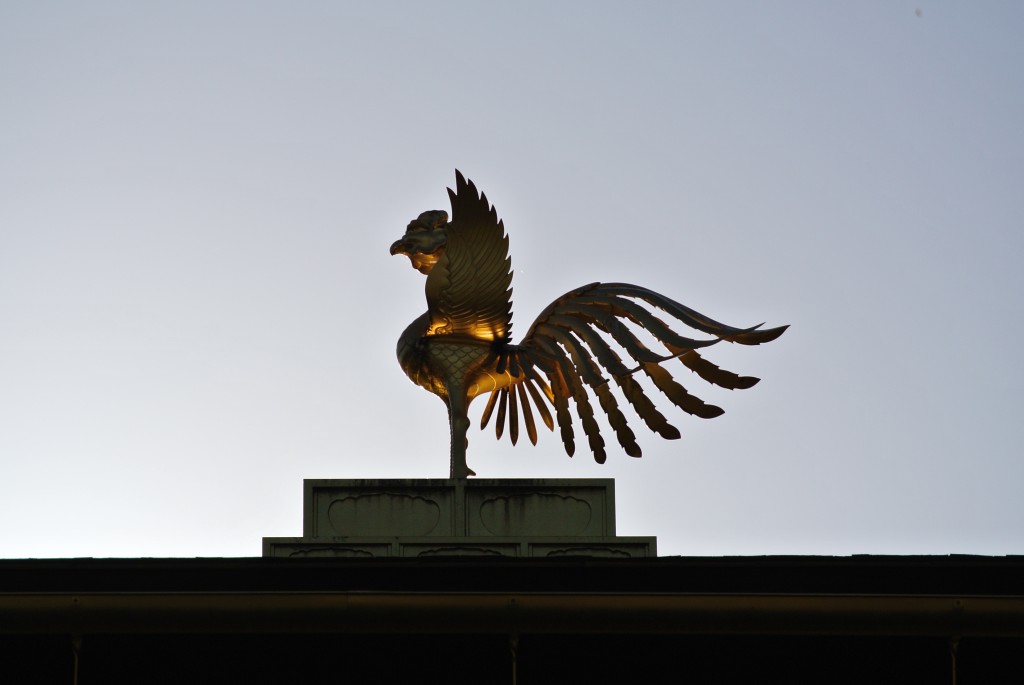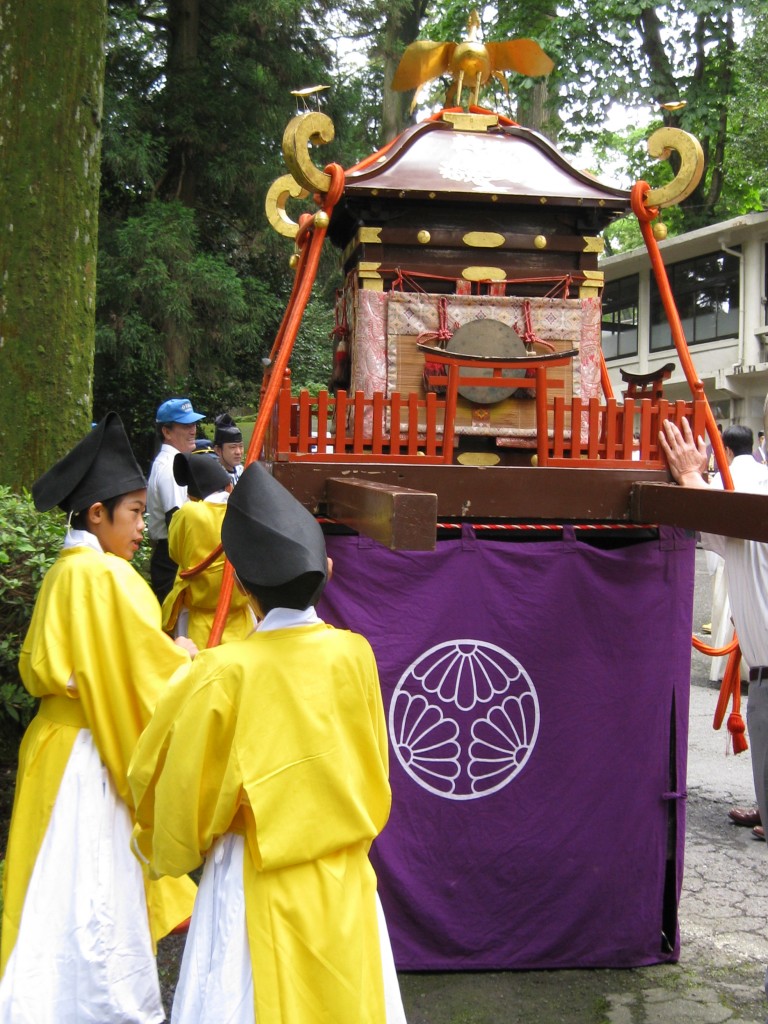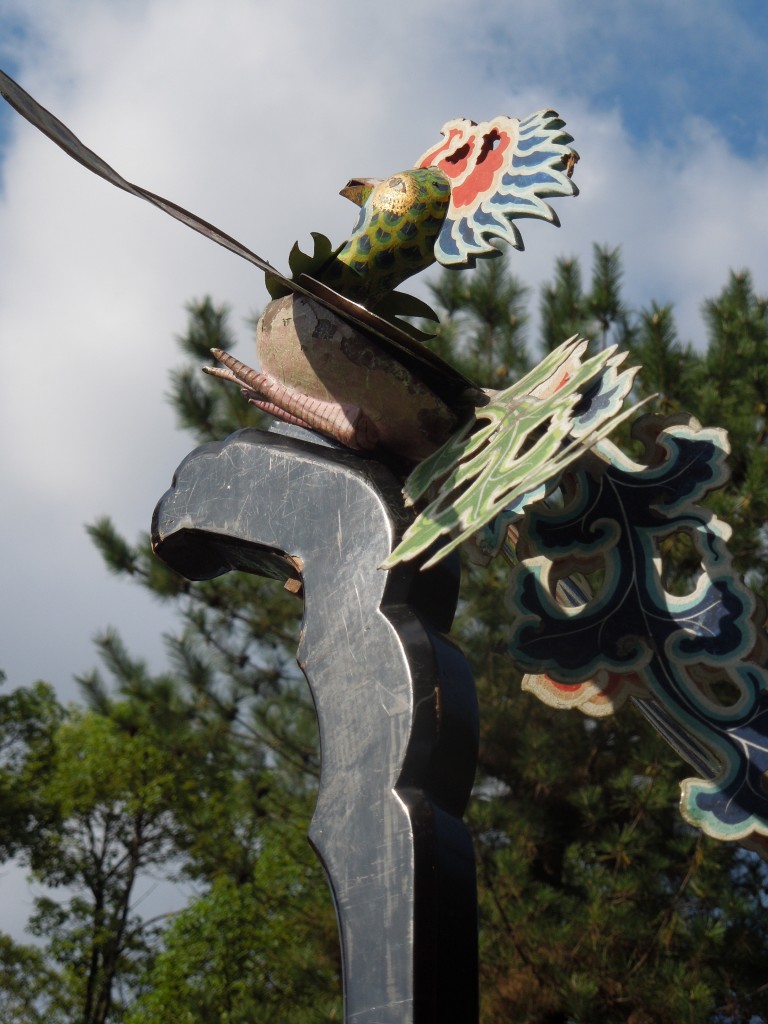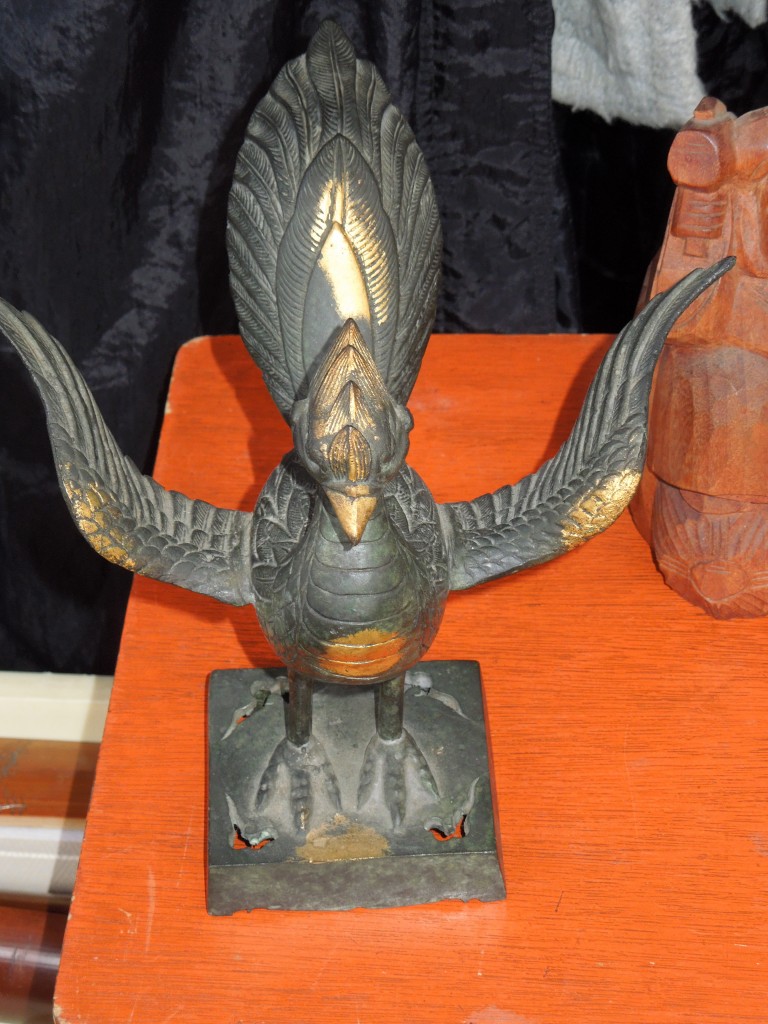
Detail of the phoenix on the rooftop of Kinkaku-ji, Kyoto's Temple of the Golden Pavilion
One thing I’ve noticed on my visits to shrines and temples is the number of times one comes across the phoenix (ho-o). It’s a popular item on mikoshi (portable shrine), and it stands famously on the top of Kyoto’s Golden Pavilion and the gorgeous Byodo-in south of the city. It’s a legendary bird in the West because of rising from the ashes, and it’s associated with the Greeks and Christianity as a symbol of rebirth. But what of its significance in the East? Here, first of all, is Wikipedia’s take on the matter.
******************************************************************************************
Wikipedia
Images of an ancient bird have appeared in China for over 8000 years, as earliest as the Hongshan neolithic period, on jade and pottery motifs, then decorating bronze as well as jade figurines. Some believe they may have been a good-luck totem among eastern tribes of ancient China.

Portable shrines have mirrors, torii and invariably a bird or birds on the roof. But why?
During the Han Dynasty (2,200 years ago) two phoenixes, one a male (feng, 鳳) and the other a female (huang, 凰) were often shown together facing one other. Later, during the Yuan Dynasty the two terms were merged to become fenghuang, generally translated as “phoenix”.
Also during this period, the fenghuang (phoenix) was used as a symbol representing the direction south. This was portrayed through a male and female facing each other. Their feathers were of the five fundamental colors: black, white, red, green, and yellow. These colors are said to represent the Confucian five virtues.
The phoenix represented power sent from the heavens to the Empress. If a phoenix was used to decorate a house it symbolized that loyalty and honesty were in the people that lived there. Or alternatively, phoenix only stays when the ruler is without darkness and corruption.
The fenghuang of the Chinese, said to live on the Kunlun mountains, is also called the “August Rooster” (Chinese: 鶤雞; pinyin: kūnjī) with solar symbolism as an animal signalling the dawn sun and since it sometimes takes the place of the Rooster in the Chinese zodiac, it is a symbol with positive connotations, symbolic of high virtue, grace and prosperity.
The Chinese fenghuang was also often portrayed as a male-female yin-yang pair of birds, with the female being an emblem for the Empress. The Chinese regard the phoenix as a rare phenomenon, seen only in times of peace, and symbolizing conjugal bliss.
The Japanese rooster is associated with Amaterasu, and a Phoenix or Rooster often sits on top of the mikoshi during a festival. This identification of the phoenix with another solar symbol and sunbird August-Rooster, suggests another intriguing connection — one with the Hepthalites (alternatively, the Hata clan [immigrants from the continent who settled in many areas, particularly Kyoto].
****************************************************************************
The Japanese Mythology and Folklore website, from which the extract below has been adapted, takes a slightly different line by tracing the roots in the Indian subcontinent and an evolution from raptor to rooster. The primacy of Amaterasu and the notion of the phoenix-rooster as a familiar of the sun would thus explain the prevalence of the bird on Shinto mikoshi. But it still leaves me wondering: was the bird first introduced to Japan through continental Buddhism? Did it merge with shamanic notions of birds as messengers of the gods and of humans in trance taking flight? When is a phoenix mythological, and when is it a plain rooster?
***************************************************************************
A number of preliminary observations about the early phase in the evolution of the phoenix: The Indo-Iranians seem to have started out with a tale of two birds — two raptor birds – falcon or eagle-hawk types. The etymological cognate Sanskrit śyenaḥ (“raptor, eagle, bird of prey”) also appears as a divine figure. Saēna is also a personal name, which is the root of the name.

Phoenix on a pole at a festival held at Yasui Konpira-gu in Kyoto
The bird icons have to do with fortune, health and wealth or prosperity, including nourishing rain for a bounty of crops. Saena is a rain-bringer (with a role much like a sky- or thunder-deity). The bird is seen as withering the tree in the Bundishne… i.e. scorching the tree and therefore associated with the sun. Therefore, it may have been the origin of the Phoenix as Sunbird.
The evolution of the phoenix as a fertility and healing symbol (eagle) has to do with the top of the Hom Tree. In Korea and Japan, the phoenix’s association with Hom tree shows evident strong influences from the Chinese Han dynasty as well as Iranian or Persian ones, due to Silk Road exchanges and trading activities. Ho-o Bird in Japan originated from Hom?
The idea of a bird as a messenger of the Sky God or sky deities, becomes a cornerstone of the myths of divine kingship or heavenly descent in East Asia, and sacred birds feature prominently in many court-chronicled myths as well as folklore surrounding the royals of Korea and Japan. Genetically and culturally, the Koreans (and lineage-related Japanese) are closely related to ancient North and Northeast Asian populations.
Given that Jewish or Hebrew communities were known to have existed in various parts of China like Kaifeng, Luoyang and elsewhere in South China, we also cannot discount the intriguing possibility that the Japanese phoenix called Ho-o may be derived from a source connected to Jewish (or Jewish-Iranian) priestly lineages because the Rabbis called the phoenix the hol phoenix, the closest etymology for the Japanese phoenix so far.

Statue of a phoenix on sale at the Kitano flea market (Tenjin-san)

The kanji for phoenix, 鳳凰, are of ancient origin and probably predate the founding period of Jewish mythology. Check them out in an etymological kanji dictionary, they are fascinating!
Thanks for the historical background and the overview of the phoenix symbology. I didn’t know there was such a conncection with Western Asia/Middle East.